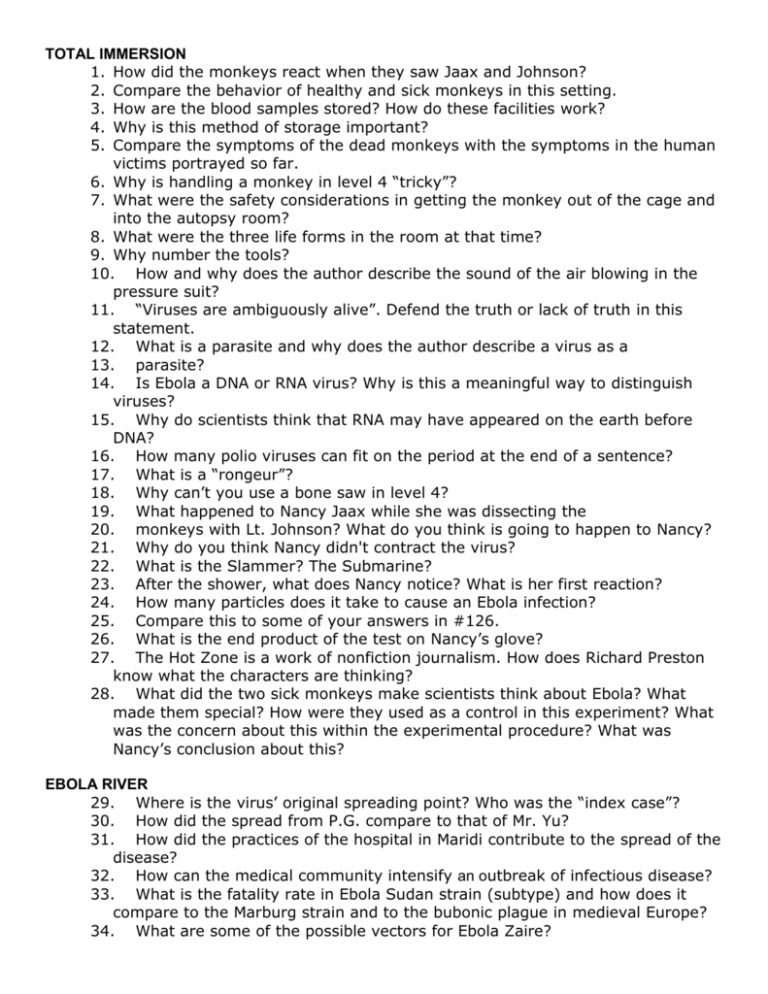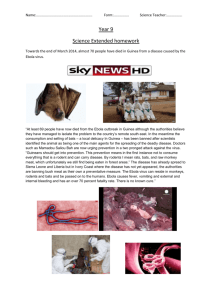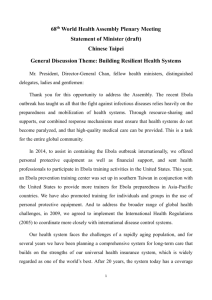TOTAL IMMERSION How did the monkeys react when they saw
advertisement

TOTAL IMMERSION 1. How did the monkeys react when they saw Jaax and Johnson? 2. Compare the behavior of healthy and sick monkeys in this setting. 3. How are the blood samples stored? How do these facilities work? 4. Why is this method of storage important? 5. Compare the symptoms of the dead monkeys with the symptoms in the human victims portrayed so far. 6. Why is handling a monkey in level 4 “tricky”? 7. What were the safety considerations in getting the monkey out of the cage and into the autopsy room? 8. What were the three life forms in the room at that time? 9. Why number the tools? 10. How and why does the author describe the sound of the air blowing in the pressure suit? 11. “Viruses are ambiguously alive”. Defend the truth or lack of truth in this statement. 12. What is a parasite and why does the author describe a virus as a 13. parasite? 14. Is Ebola a DNA or RNA virus? Why is this a meaningful way to distinguish viruses? 15. Why do scientists think that RNA may have appeared on the earth before DNA? 16. How many polio viruses can fit on the period at the end of a sentence? 17. What is a “rongeur”? 18. Why can’t you use a bone saw in level 4? 19. What happened to Nancy Jaax while she was dissecting the 20. monkeys with Lt. Johnson? What do you think is going to happen to Nancy? 21. Why do you think Nancy didn't contract the virus? 22. What is the Slammer? The Submarine? 23. After the shower, what does Nancy notice? What is her first reaction? 24. How many particles does it take to cause an Ebola infection? 25. Compare this to some of your answers in #126. 26. What is the end product of the test on Nancy’s glove? 27. The Hot Zone is a work of nonfiction journalism. How does Richard Preston know what the characters are thinking? 28. What did the two sick monkeys make scientists think about Ebola? What made them special? How were they used as a control in this experiment? What was the concern about this within the experimental procedure? What was Nancy’s conclusion about this? EBOLA RIVER 29. Where is the virus’ original spreading point? Who was the “index case”? 30. How did the spread from P.G. compare to that of Mr. Yu? 31. How did the practices of the hospital in Maridi contribute to the spread of the disease? 32. How can the medical community intensify an outbreak of infectious disease? 33. What is the fatality rate in Ebola Sudan strain (subtype) and how does it compare to the Marburg strain and to the bubonic plague in medieval Europe? 34. What are some of the possible vectors for Ebola Zaire? 35. Take stock! What would happen if Ebola was let loose in a hospital? You would be safe, you’re in a hospital. Is this theory correct? Give five reasons why you feel safe or unsafe and one piece of evidence to support your position. 36. Compare the cleanliness of the hospitals in America to the Yambuku Hospital. 37. What did the nuns at the Yambuku Hospital do to sterilize used syringes? What recommendations would you make to improve this practice? 38. The Sudan virus subsides, then vanishes. Can you explain why this might be happening? What are two possible reasons the outbreak burned itself out? 39. Define hot as it is used in this book. 40. How did the trip to the market contribute to the outbreak of the disease? 41. After the first recorded patient, how many villages were infected? What does this tell you about the possible location of the infection? What are the levels of spread of the disease? 42. What is “pavementing” in biological terms? What are “bricks”? 43. What is Ebola’s favorite protein food? 44. What is Ebola’s “strategy for success”? 45. What is so important about Nurse Mayinga’s story? Why doesn’t she go into quarantine for her condition? 46. Why does the author shift to the present tense while telling this story? 47. What were some of the options of the government upon finding out this story? 48. What did the President do? 49. What happened to sister M.E.’s blood? Where did it go? 50. Who is Dr. Karl Johnson and what office does he head up? 51. What is the condition of the sample when it arrives at the CDC? 52. What precautions does Patricia Webb take in handling it? 53. Who is Fred Murphy and what is his specialty? 54. What about the picture scares Murphy? What did he do next? 55. What is the characteristic shape they notice? Why did they decide it was a new strain? 56. Using the magnification of the picture on page 118, what is the size of the virus? 57. If you’re Karl Johnson, what do you pack for a trip to Africa to study and contain a deadly virus? 58. Johnson says “I’m glad nature is not benign”. What do you think he means? Do you agree or disagree and why? 59. What are the implications if Ebola is airborne? 60. What is a species threatening event? 61. “A virus can be useful to a species by thinning it out.” 62. What % of Europeans were killed by the plague in the 14th 63. century? What % of Americans were killed by the flu in 1918? 64. Who is Joel Breman and what does he do? Why is he so afraid? 65. How would you feel in his situation? 66. How did the CDC team ultimately get to Bumba? 67. How did the native crew react upon landing? 68. How did the Belgian doctor on the scene handle the situation? 69. What was the purpose of felling trees on the road between villages? Describe the process of reverse quarantine. 70. Why were they burning mattresses? 71. “The red chamber of the virus queen” is a metaphor to what other organism? 72. What were some of the steps that the villagers had taken to control the spread of the disease on their own? 73. Define iatrogenesis and explain the emotion of the villagers to find out that the disease had spread in the hospital, among the nuns who had come to help them. 74. How did Nurse Mayinga die? How many contacts had she had before being hospitalized? 75. How did they store the bodies to prevent spread? 76. How did Karl Johnson set up an isolated hospital in this setting? 77. In the end, did the first Zaire outbreak show symptoms of airborne transmission? CARDINAL 78. As the courier passed the sample of Peter Cardinal’s blood to Gene Johnson at the airport, think about how this would take place after 9/11. What would have been different? 79. How was the sample stored for safety handling? How many levels of physical and biological protection were there? 80. What happened to Peter Cardinal? 81. What is “third spacing” and why were his symptoms concerning about an airborne infection? 82. Write a short story about what would happen if a student came back from Africa and brought Ebola to the campus? 83. What is the distinction between parasites and predators? 84. Describe the shape of the virus particle called the 'shepherd's crook." 85. Take stock! What would you do in Nancy Jaax's situation? 86. What hospital did Nurse Mayinga work at? 87. What happened to Peter Cardinal? 88. How did Gene Johnson culture the sample of Peter Cardinal’s blood serum? Describe the three steps of this experimental protocol. 89. What does the relative lethality rate in animal species tell us about the original host or reservoir species? 90. What did Lt. Johnson discover about Peter Cardinal and where he had been? 91. What did Lt. Johnson's team discover in Kitum Cave? GOING DEEP 92. In investigating Peter Cardinal’s family’s house, why were they interested in the animals? 93. Describe the experiment in 1988 that confirmed that Ebola could travel through the air. 94. What did the U.S. Army scientific team members wear in Kitum Cave to protect themselves? What other kinds of equipment did they carry to increase their safety? 95. There were 35 specialists on this trip. What were some of their fields of expertise? 96. What are sentinel animals? Give two examples. 97. How did they set up the containment facility as they approached the cave? 98. Who locally would be likely to have a Racal suit and why? 99. What were the methods used to collect samples? Describe how light traps and pitfall traps work. 100. Which other organisms did they test and collect samples from? 101. What is an antibody and how does this test confirm the presence or absence of a virus? 102. What were the results of these tests? 103. What does Pasteur’s quote “chance favors the prepared mind” mean? What were Pasteur’s contributions to our knowledge of bacteria and fungi? 104. What was Nancy Jaax’s new job? How did she and Jerry get back to USAMRIID?





